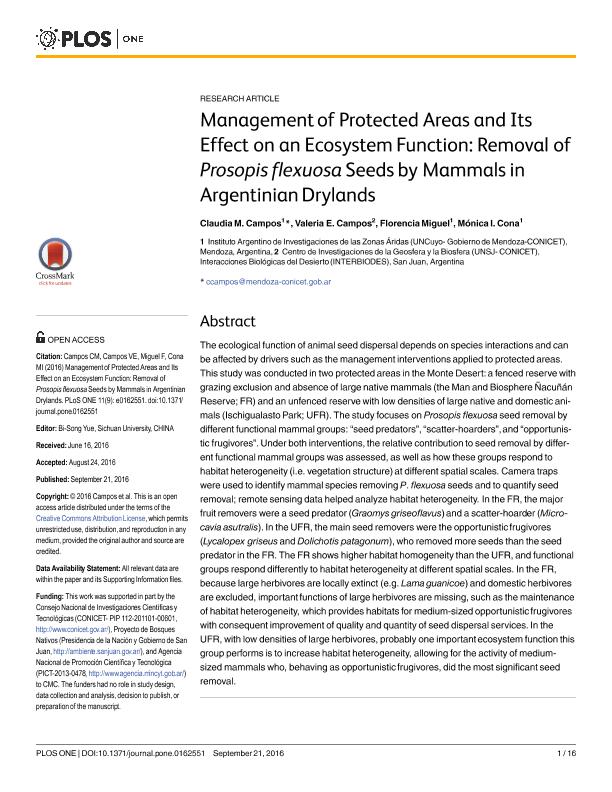Artículo
Management of protected areas and its effect on an ecosystem function: Removal of Prosopis flexuosa seeds by mammals in argentinian drylands
Fecha de publicación:
21/09/2016
Editorial:
Public Library of Science
Revista:
Plos One
ISSN:
1932-6203
Idioma:
Inglés
Tipo de recurso:
Artículo publicado
Clasificación temática:
Resumen
The ecological function of animal seed dispersal depends on species interactions and can be affected by drivers such as the management interventions applied to protected areas. This study was conducted in two protected areas in the Monte Desert: a fenced reserve with grazing exclusion and absence of large native mammals (the Man and Biosphere Ñacuñán Reserve; FR) and an unfenced reserve with low densities of large native and domestic animals (Ischigualasto Park; UFR). The study focuses on Prosopis seed removal by different functional mammal groups: "seed predators", "scatterhoarders", and "opportunistic frugivores". Under both interventions, the relative contribution to seed removal by different functional mammal groups was assessed, as well as how these groups respond to habitat heterogeneity (i.e. vegetation structure) at different spatial scales. Camera traps were used to identify mammal species removing Prosopis seeds and to quantify seed emoval; remote sensing data helped analyze habitat heterogeneity. In the FR, the major fruit removers were a seed predator (Graomys griseoflavus) and a scatter-hoarder (Microcavia asutralis). In the UFR, the main seed removers were the opportunistic frugivores (Lycalopex griseus and Dolichotis patagonum), who removed more seeds than the seed predator in the FR. The FR shows higher habitat homogeneity than the UFR, and functional groups respond differently to habitat heterogeneity at different spatial scales. In the FR, because large herbivores are locally extinct (e.g. Lama guanicoe) and domestic herbivores are excluded, important functions of large herbivores are missing, such as the maintenance of habitat heterogeneity, which provides habitats for medium-sized opportunistic frugivores with consequent improvement of quality and quantity of seed dispersal services. In the UFR, with low densities of large herbivores, probably one important ecosystem function this group performs is to increase habitat heterogeneity, allowing for the activity of medium-sized mammals who, behaving as opportunistic frugivores, did the most significant seed removal.
Archivos asociados
Licencia
Identificadores
Colecciones
Articulos(CIGEOBIO)
Articulos de CENTRO DE INVESTIGACIONES DE LA GEOSFERA Y BIOSFERA
Articulos de CENTRO DE INVESTIGACIONES DE LA GEOSFERA Y BIOSFERA
Articulos(IADIZA)
Articulos de INST. ARG DE INVEST. DE LAS ZONAS ARIDAS
Articulos de INST. ARG DE INVEST. DE LAS ZONAS ARIDAS
Citación
Campos, Claudia Monica; Campos, Valeria Evelin; Miguel, María Florencia; Cona, Monica Ines; Management of protected areas and its effect on an ecosystem function: Removal of Prosopis flexuosa seeds by mammals in argentinian drylands; Public Library of Science; Plos One; 11; 9; 21-9-2016; 1-16; e0162551
Compartir
Altmétricas




